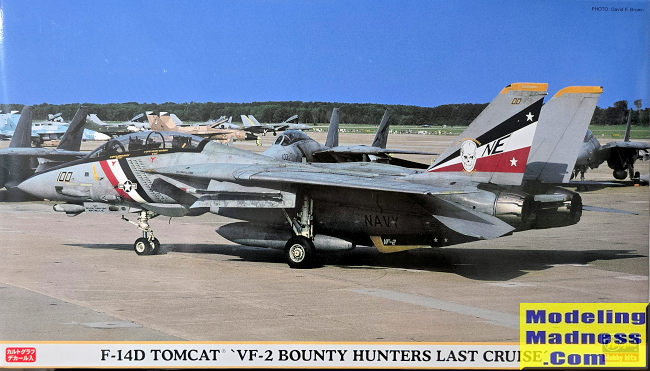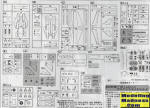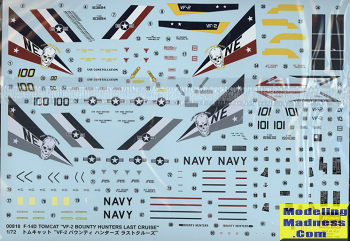
Hasegawa 1/72 F-14D Tomcat 'VF-2 Bounty Hunters Last Cruise'
| KIT #: | 00818 |
| PRICE: | 3000 yen SRP |
| DECALS: | Two options |
| REVIEWER: | Scott Van Aken |
| NOTES: | 2006 Limited Edition |

| HISTORY |
The Grumman F-14 Tomcat is a supersonic, twin-engine, two-seat, variable-sweep wing fighter aircraft. The Tomcat was developed for the United States Navy's Naval Fighter Experimental (VFX) program following the collapse of the F-111B project. The F-14 was the first of the American teen-series fighters, which were designed incorporating the experience of air combat against MiG fighters during the Vietnam War.
The F-14 first flew in December 1970 and made its first deployment in 1974 with the U.S. Navy aboard USS Enterprise (CVN-65), replacing the McDonnell Douglas F-4 Phantom II. The F-14 served as the U.S. Navy's primary maritime air superiority fighter, fleet defense interceptor and tactical aerial reconnaissance platform. In the 1990s, it added the Low Altitude Navigation and Targeting Infrared for Night (LANTIRN) pod system and began performing precision ground-attack missions.
Throughout most of its life, the F-14 was hampered by the TF-30 engines originally designed for the F-111B. These caused some issues and did not allow the full utilization of the Tomcat's design capabilities. It was planned on using F-401 engines but issues with the engines and budget concerns shelved that. It wasn't until many years later that the F-110 engine was installed in some F-14A airframes making those F-14A+ and later F-14B aircraft. The upgraded F-14D had these same engines and upgraded digital avionics with about half of the F-14D production being reworked F-14As.
In the 1980s F-14s were used as land-based interceptors by the Islamic Republic of Iran Air Force during the Iran–Iraq War, where they saw combat against Iraqi warplanes. Iranian F-14s reportedly shot down at least 160 Iraqi aircraft during the war, while only 12 to 16 Tomcats were lost; at least half of these losses were due to accidents.
The Tomcat was retired from the U.S. Navy's active fleet on 22 September 2006, having been supplanted by the Boeing F/A-18E/F Super Hornet. The F-14 remains in service with the Islamic Republic of Iran Air Force, having been exported to Iran in 1976, when the U.S. had amicable diplomatic relations with Iran. VF-213 was one of the small number of F-14 units that transitioned to the F-18F.
| THE KIT |
 Hasegawa
has reboxed the Tomcat at least five dozen times, judging by my slowly growing
collection of F-14 kits. You would think that they'd have run out of options for
their Limited Editions, but based on this new release, that isn't the case. It
was natural that they'd get the most out of what has to have been an expensive
molding, judging by the plethora of small parts and inserts that come with the
kits. There are so many parts that the box is actually bulging in an attempt to
keep them from escaping. You can see the number of bits and pieces from the
image above. In many ways, this is just a smaller version of the larger and
equally impressive 1/48 F-14 that Hasegawa has produced. Typical of Hasegawa,
the kit came with all those sprues in two bags.
Hasegawa
has reboxed the Tomcat at least five dozen times, judging by my slowly growing
collection of F-14 kits. You would think that they'd have run out of options for
their Limited Editions, but based on this new release, that isn't the case. It
was natural that they'd get the most out of what has to have been an expensive
molding, judging by the plethora of small parts and inserts that come with the
kits. There are so many parts that the box is actually bulging in an attempt to
keep them from escaping. You can see the number of bits and pieces from the
image above. In many ways, this is just a smaller version of the larger and
equally impressive 1/48 F-14 that Hasegawa has produced. Typical of Hasegawa,
the kit came with all those sprues in two bags.
As demanded, the panel lines are engraved and the kit offers the ability to have the flaps and slats deployed. In fact, to do it otherwise will require a bit of surgery to be done on the slat tracks. You can also position the glove vanes open or closed. Again, some surgery is needed for the closed position. All F-14s had them wired in the closed position after it was realized that they didn't really do anything and were an additional maintenance hassle. New build F-14Ds did not have them at all. You also have the ability to have the speed brakes and entrance steps/ladder open or closed, and two different tails, though one set is not for this particular boxing. So much has the F-14 been modified and updated over the years that you really need to have photographs of the aircraft that you are modeling to get everything right.
As required by its price, this kit comes with a small fret of etched
metal. These bits are for the interior, canopy and exhaust. The metalwork is
very well done and should really enhance your Tomcat. For this kit, you get a
standard set of instructions with an addendum sheet showing the D model
differences. The instructions are very well done as you would expect.
They offer color callouts based on Gunze paint as is the norm with Hasegawa over
the last decades. Every option
and difference between the aircraft on the decal sheet is given so that you can
do a proper job of things.

Two markings options are provided, both from VF-2. One is the CAG bird as shown on the box art, replete with mission markings. This plane is in the tactical paint sheme. While the rudder and fin tips are provided by decals, you will need to paint the cockpit exterior and surround. The other aircraft is the CO's plane with all the markings in shades of grey. The decal sheet is nicely done and is as good as any aftermarket.
| CONCLUSIONS |
Despite their age, these are still excellent kits that offer a ton of detail for the money. You still have to get a weapons set if you want your's armed, but then you get enough stuff to last for a while.
August 2024
Copyright ModelingMadness.com. All rights reserved. No reproduction in part or in whole without express permission from the editor.
If you would like your product reviewed fairly and fairly quickly, please contact the editor or see other details in the Note to Contributors.